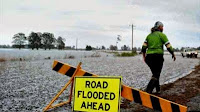Twenty-one people have been confirmed dead and many more are feared to have lost their lives after Cyclone Winston swept across the island nation of Fiji on Saturday 20 February 2016. The Catagory Five storm (defined as a storm with sustained windspeeds in excess of 250 kilometers per hour - a sustained windspeed is defined as a windspeed recorded continuously
for periods in excess of a minute - and gusts of up to 300 kilometers per
hour) made landfall on the north of Fiji's main island, Viti Levu, at about 6.30 pm local time, brining with it windspeeds of up to 320 kilometers per hour and a storm surge of about 12 m, making it one of the most powerful storms ever recorded in the Southern Hemisphere. The storm narrowly missed the capitol, Suva, but brought widespread devastation to the islands, destroying homes, crops, businesses, public buildings and other infrastructure, and leaving about 720 000 people (out of a population of about 900 000) without electricity. The worst destruction is thought to have occured on the island of Koro, but the extent of damage across many of the smaller of the nations 300 islands is completely unknown.
Aerial photograph of damage near Tamavua on Viti Levu taken by the Royal New Zealand Air Force. AFP/Getty Images.
Tropical
cyclones are caused by solar energy heating the air above the oceans,
which causes the air to rise leading to an inrush of air. If this
happens over a large enough area the inrushing air will start to
circulate, as the rotation of the Earth causes the winds closer to the
equator to move eastwards compared to those further away (the Coriolis
Effect). This leads to tropical storms rotating clockwise in the
southern hemisphere and anticlockwise in the northern hemisphere.These
storms tend to grow in strength as they move across the ocean and lose
it as they pass over land (this is not completely true: many tropical
storms peter out without reaching land due to wider atmospheric
patterns), since the land tends to absorb solar energy while the sea
reflects it.
The
low pressure above tropical storms causes water to rise there by ~1 cm
for every millibar drop in pressure, leading to a storm surge that can
overwhelm low-lying coastal areas, while at the same time the heat leads
to high levels of evaporation from the sea - and subsequently high
levels of rainfall. This can cause additional flooding on land, as well
as landslides.
The passage of Cyclone Winston till 12.00 GMT on Monday 22 February 2016 (thick
line) with its predicted future path (thin line, circles represent the
margin of error on the predictions). Colours indicate the strength of
the storm. Tropical Storm Risk.
See also...
 At least eight dead as Cyclone Pam sweeps across Vanuatu. Eight people are known to have died and it is feared that the death toll
will rise sharply after Cyclone Pam swept across the island...
At least eight dead as Cyclone Pam sweeps across Vanuatu. Eight people are known to have died and it is feared that the death toll
will rise sharply after Cyclone Pam swept across the island...  Cyclone Evan kills at least two in Samoa. Cyclone Evan hit the island of Samoa on Thursday 13 December 2012,
leading to widespread flooding and causing the Vaisigano River to burst
its banks in the capitol, Apia. At least three people are believed to...
Cyclone Evan kills at least two in Samoa. Cyclone Evan hit the island of Samoa on Thursday 13 December 2012,
leading to widespread flooding and causing the Vaisigano River to burst
its banks in the capitol, Apia. At least three people are believed to...
Heavy
rainfall associated with Cyclone Grant (now downgraded to Tropical
Storm Grant) has caused serious problems along the Edith River in...
Follow Sciency Thoughts on Facebook.




